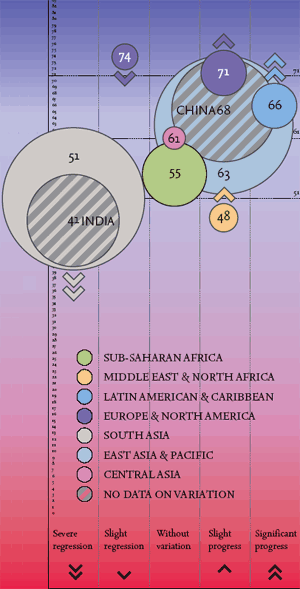NO PROGRESS THERE WHERE IT IS NEEDED THE MOST
 |
The Gender Equity Index 2009 computed by Social Watch shows that the gender gap is not narrowing in most countries and a majority of the countries that show progress are those that were already comparatively better. The distance between the countries and regions in the better and worse relative situations has widened in the last years. In education and economic activity the situation of women has globally improved, but when it comes to empowerment some 15% of countries have regressed over the past year, and this has been so severe that the average global value of this indicator fell from 35% in 2008 to 34.5% in 2009.
Sweden and Finland still have the highest values on the Gender Equity Index. Rwanda, which for years has figured among the most equitable countries in terms of gender, has moved up to third place, overtaking Germany and Norway and the Bahamas has risen from sixth to fifth.
The GEI makes it very clear that differences in income between countries are not directly correlated to gender inequity. Many poor countries have reached high levels of equity, even when the absolute situation of both women and men is one where too many live in poverty. On the other hand, in many countries that have acceptable average social indicators these satisfactory figures mask the fact that there are huge gaps between men and women.
A bad gender equity situation is associated with regression whereas a good starting situation favours progress: of the countries in the worse relative situation more than half (51.6%) regressed (slightly or severely), while more than half (77.1%) of those in a comparatively better situation made progress (slight or significant). This shows a structural and dynamic polarization in which, for the most part, the countries with higher equity index tend to evolve favourably, regardless of whether they are rich or poor or in what region they are located, while countries with higher levels of gender discrimination tend to get worse in this respect. In terms of regions, the paradigm examples of this polarization are Latin America and the Caribbean on the one hand and East Asia and the Pacific on the other.
|
GEI 2009
|
No progress there where it is needed the most |
Measuring inequity: the 2009 Gender Equity Index |
GEI regional average by component | THE THREE GAPS |


